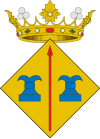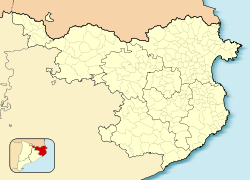Sant Mori
| Sant Mori | |||
|---|---|---|---|
| Municipality | |||

Castle of Sant Mori
|
|||
|
|||
| Location in Catalonia | |||
| Coordinates: 42°09′N 2°59′E / 42.150°N 2.983°ECoordinates: 42°09′N 2°59′E / 42.150°N 2.983°E | |||
| Country |
|
||
| Community |
|
||
| Province | Girona | ||
| Comarca | Alt Empordà | ||
| Government | |||
| • Mayor | Modesta Cucurull Nadal (2015) | ||
| Area | |||
| • Total | 7.5 km2 (2.9 sq mi) | ||
| Elevation | 51 m (167 ft) | ||
| Population (2014) | |||
| • Total | 177 | ||
| • Density | 24/km2 (61/sq mi) | ||
| Demonym(s) | santmorienc / santmorienca | ||
| Website | www |
||
Sant Mori is a municipality in the comarca of Alt Empordà, Girona, Catalonia, Spain.
Situated on the right bank of the river Fluvià, it is limited on the north by Sant Miquel de Fluvià, on the east by Ventalló, on the south by Saus and on the west by Palau de Santa Eulàlia.
The economy is based on agriculture and animal husbandry, it has a small electricity generator and tourism is becoming more important.
Sant Mori was a barony in the 15th century and in 1893 it became a marquisate. The regent queen Juana Enríquez and her son Ferdinand II of Aragon spent some days in the castle of Sant Mori at the height of the war against John II of Aragon. There the Parliament of the Corts Catalanes were invoked on October 1466.
...
Wikipedia




